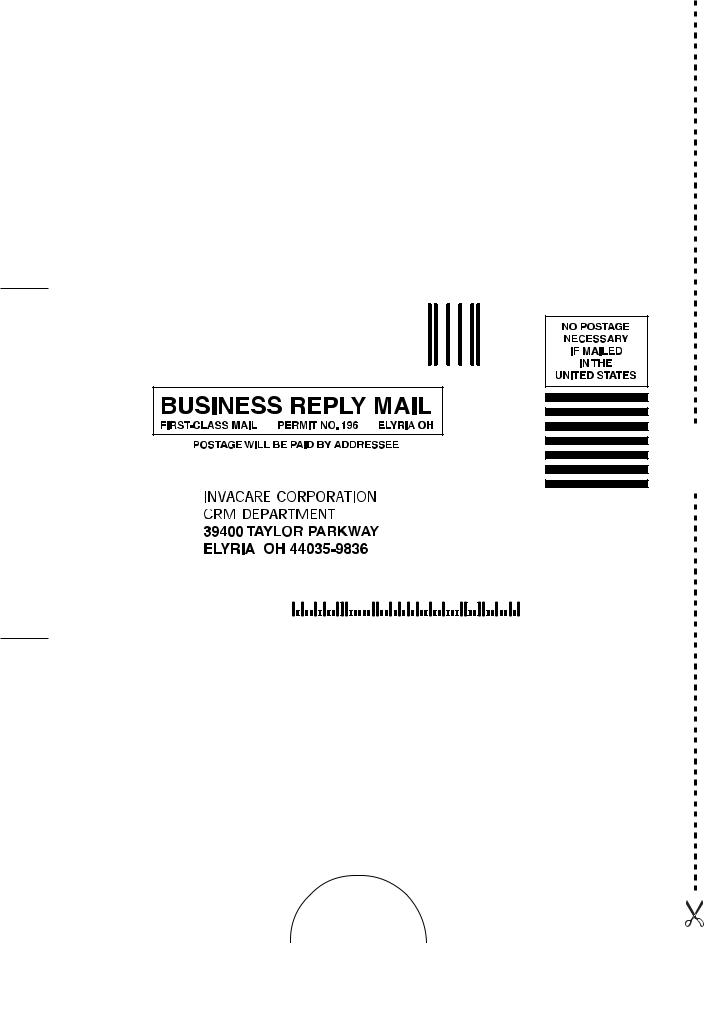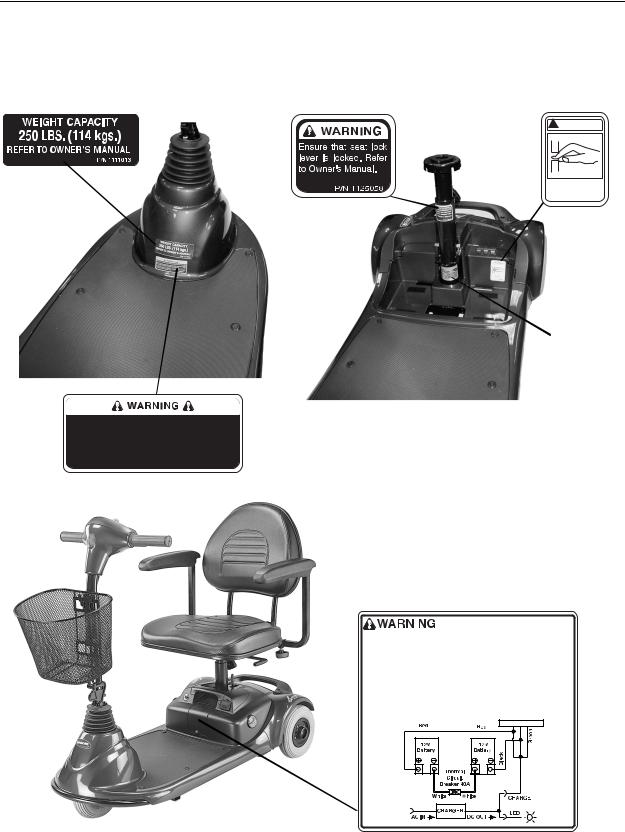Invacare L-4 User Manual

Owner’s Operator and Maintenance Manual
Lynx™L-3 & Lynx L-4
DEALER: This manual MUST be given to the user of the scooter.
USER: BEFORE using this scooter, read this manual and save for future reference.
For more information regarding Invacare products, parts, and services, please visit www.invacare.com

WARNING
POWERED SCOOTER USERS: DO NOT SERVICE OR OPERATE THIS EQUIPMENT WITHOUT FIRST READING AND UNDERSTANDING THE OWNER’S OPERATOR AND MAINTENANCE MANUAL. IF YOU ARE UNABLE TO UNDERSTAND THE WARNINGS, CAUTIONS, AND INSTRUCTIONS, CONTACT INVACARE TECHNICAL SUPPORT BEFORE ATTEMPTING TO SERVICE OR OPERATE THIS EQUIPMENT - OTHERWISE INJURY OR DAMAGE MAY RESULT.
PROCEDURES OTHER THAN THOSE DESCRIBED IN THIS MANUAL MUST BE PERFORMED BY A QUALIFIED TECHNICIAN.
DEALERS AND QUALIFIED TECHNICIANS: DO NOT SERVICE OR OPERATE THIS EQUIPMENT WITHOUT FIRST READING AND UNDERSTANDING THE OWNER’S OPERATOR AND MAINTENANCE MANUAL AND THE SERVICE MANUAL (IF APPLICABLE). IF YOU ARE UNABLE TO UNDERSTAND THE WARNINGS, CAUTIONS AND INSTRUCTIONS, CONTACT INVACARE TECHNICAL SUPPORT BEFORE ATTEMPTING TO SERVICE OR OPERATE THIS EQUIPMENT - OTHERWISE, INJURY OR DAMAGE MAY RESULT.
NOTE: Updated versions of this manual are available on www.invacare.com.
Lynx™L-3 & Lynx L-4 |
2 |
Part No. 1143205 |

TABLE OF CONTENTS |
|
TABLE OF CONTENTS |
|
REGISTER YOUR PRODUCT ............................................................... |
4 |
SPECIAL NOTES ................................................................................ |
7 |
TYPICAL PRODUCT PARAMETERS .................................................... |
9 |
LABEL LOCATIONS ......................................................................... |
10 |
SECTION 1—GENERAL GUIDELINES ................................................. |
11 |
Repair or Service Information ............................................................................................................... |
11 |
Operation Information............................................................................................................................ |
11 |
Electrical ..................................................................................................................................................... |
13 |
Batteries...................................................................................................................................................... |
14 |
Rain Test..................................................................................................................................................... |
14 |
Weight Training ........................................................................................................................................ |
14 |
Weight Limitation..................................................................................................................................... |
14 |
SECTION 2—EMI INFORMATION ..................................................... |
15 |
SECTION 3—SAFETY/HANDLING OF POWERED SCOOTERS ................ |
17 |
Stability and Balance................................................................................................................................. |
17 |
Stairways..................................................................................................................................................... |
18 |
Escalators.................................................................................................................................................... |
18 |
SECTION 4—SAFETY INSPECTION ................................................... |
19 |
Safety Inspection Checklists................................................................................................................... |
19 |
SECTION 5—MAINTENANCE AND TROUBLESHOOTING ................... |
22 |
Suggested Maintenance Procedures ..................................................................................................... |
22 |
Troubleshooting........................................................................................................................................ |
23 |
Service Indicator Error Codes .............................................................................................................. |
24 |
Resetting the Circuit Breaker................................................................................................................ |
25 |
SECTION 6—OPERATION OF THE POWERED SCOOTER ..................... |
26 |
Control Panel ............................................................................................................................................ |
26 |
Operating the Scooter ............................................................................................................................ |
27 |
Engaging/Disengaging the Brake Release Lever ................................................................................. |
29 |
SECTION 7—SEAT AND ARMS ......................................................... |
30 |
Removing/Installing the Seat................................................................................................................... |
30 |
Adjusting Seat Height............................................................................................................................... |
31 |
Adjusting 90° Seat Swivel ...................................................................................................................... |
32 |
Adjusting the Arm Width....................................................................................................................... |
32 |
Replacing Armrest Pads .......................................................................................................................... |
33 |
Part No. 1143205 |
3 |
Lynx™L-3 & Lynx L-4 |

TABLE OF CONTENTS |
|
TABLE OF CONTENTS |
|
SECTION 8—TILLER ADJUSTMENT ................................................... |
34 |
Adjusting the Tiller Angle ....................................................................................................................... |
34 |
SECTION 9—WHEELS AND CASTERS ................................................ |
35 |
Removing/Installing the Drive Wheels ................................................................................................ |
35 |
Removing/Installing the Front Wheel .................................................................................................. |
36 |
SECTION 10—BATTERIES ................................................................ |
37 |
Recommended Battery Type ................................................................................................................. |
37 |
Removing/Installing the Battery Box .................................................................................................... |
38 |
Removing/Installing the Batteries.......................................................................................................... |
39 |
Charging the Batteries............................................................................................................................. |
41 |
SECTION 11—TRANSPORTING ........................................................ |
43 |
Transporting the Scooter ....................................................................................................................... |
43 |
SECTION 12—ACCESSORIES ............................................................ |
45 |
Installing/Removing the Accessory Tube ............................................................................................ |
45 |
Installing/Removing the Crutch/Cane Holder.................................................................................... |
46 |
Installing/Removing the Safety Flag ....................................................................................................... |
47 |
Installing/Removing/Using the Walker Holder ................................................................................. |
47 |
Installing/Removing the Rear Mounted Basket .................................................................................. |
49 |
LIMITED WARRANTY ..................................................................... |
51 |
REGISTER YOUR PRODUCT
The benefits of registering:
1.Safeguard your investment.
2.Ensure long term maintenance and servicing of your purchase.
3.Receive updates with product information, maintenance tips, and industry news.
4.Invacare can contact you or your provider, if servicing is needed on your product.
5.It will enable Invacare to improve product designs based on your input and needs.
Register ONLINE at www.invacare.com - or -
Complete and mail the form on the next page
Any registration information you submit will be used by Invacare Corporation only, and protected as required by applicable laws and regulations.
Part No. 1143205 |
4 |
Lynx™L-3 & Lynx L-4 |

Cut Along Line
PRODUCT REGISTRATION FORM
Register ONLINE at www.invacare.com - or -
Complete and mail this form
Name _______________________________________________________________ |
|
||||||
Address _____________________________________________________________ |
|
||||||
City ___________________State/Province __________ |
|
|
|||||
Zip/Postal Code ________ |
|
|
|
|
|
||
Email ___________________________________ Phone No. _________________ |
Fold |
||||||
Invacare Model No. ______________________ Serial No. __________________ |
here |
||||||
|
|||||||
Purchased From _________________________ Date of Purchase:___________ |
|
||||||
|
|
|
|
|
|
||
1. |
Method of purchase: (check all that apply) |
|
|
|
|
||
Medicare |
Insurance |
Medicaid |
Other |
__________________________ |
|
||
2. |
This product was purchased for use by: (check one) |
|
|
|
|||
Self |
Parent |
Spouse |
Other |
|
|
|
|
3. |
Product was purchased for use at: |
|
|
|
|
||
Home |
Facility |
Other |
|
|
|
|
|
4. |
I purchased an Invacare product because: |
|
|
|
|
||
Price |
Features (list features) _________________________________________ |
|
|||||
5. |
Who referred you to Invacare products? (check all that apply) |
|
|
||||
Doctor |
Therapist Friend Relative Dealer/Provider |
Other_________ |
|
||||
Advertisement (circle one): TV, Radio, Magazine, Newspaper |
No Referral_____ |
|
|||||
6.What additional features, if any, would you like to see on this product?
__________________________________________________________________________ Fold
7. |
Would you like information sent to you about Invacare products that may be available for a here |
|
particular medical condition? Yes No |
|
If yes, please list any condition(s) here and we will send you information by email and/or mail about |
|
any available Invacare products that may help treat, care for or manage such condition(s): |
|
__________________________________________________________________________ |
8. |
Would you like to receive updated information via email or regular mail about the Invacare |
|
home medical products sold by Invacare's dealers? Yes No |
9.What would you like to see on the Invacare website?
__________________________________________________________________________
10.Would you like to be part of future online surveys for Invacare products? Yes No
11.User's Year of birth: ______________________________________________________
If at any time you wish not to receive future mailings from us, please contact us at Invacare Corporation, CRM Department, 39400 Taylor Parkway, Elyria, OH 44035, or fax to 877-619-7996 and we will remove you from our mailing list.
To find more information about our products, visit www.invacare.com.

Fold here
 Cut Along Line
Cut Along Line
Fold here
Invacare Product Registration Form
Please Seal with Tape Before Mailing

SPECIAL NOTES
SPECIAL NOTES
Signal words are used in this manual and apply to hazards or unsafe practices which could result in personal injury or property damage. Refer to the table below for definitions of the signal words.
SIGNAL WORD |
MEANING |
|
|
|
Danger indicates an imminently hazardous situation which, if not avoided, |
DANGER |
will result in death or serious injury. |
|
|
|
Warning indicates a potentially hazardous situation which, if not avoided, |
WARNING |
could result in death or serious injury. |
|
|
|
Caution indicates a potentially hazardous situation which, if not avoided, |
CAUTION |
may result in property damage. |
|
|
|
|
NOTICE
THE INFORMATION CONTAINED IN THIS DOCUMENT IS SUBJECT TO CHANGE WITHOUT NOTICE.
As a manufacturer of powered scooters, Invacare endeavors to supply a wide variety of powered scooters to meet many needs of the end user. However, final selection of the type of powered scooter to be used by an individual rests solely with the user and his/her healthcare professional capable of making such a selection.
TIE-DOWN RESTRAINTS AND SEAT RESTRAINTS
Powered scooter users should NOT be transported in vehicles of any kind while in the powered scooter. As of this date, the Department of Transportation has not approved any tie-down systems for transportation of a user while in a powered scooter, in a moving vehicle of any type.
It is Invacare’s position that users of powered scooters should be transferred into appropriate seating in vehicles for transportation and use be made of the restraints made available by the auto industry. Invacare cannot and does not recommend any powered scooter transportation systems.
SEAT POSITIONING STRAP
It is the obligation of the Dealers, Therapists and other Healthcare Professionals to determine if a seating positioning strap is required to ensure the safe operation of this equipment by the user. Serious injury can occur in the event of a fall from a powered scooter.
WARNING
The seat positioning strap is a positioning belt only. It is not designed for use as a safety device withstanding high stress loads such as auto or aircraft safety belts. If signs of wear appear, belt MUST be replaced immediately.
Invacare products are specifically designed and manufactured for use in conjunction with Invacare accessories. Accessories designed by other manufacturers have not been tested by Invacare and are not recommended for use with Invacare products.
Part No. 1143205 |
7 |
Lynx™L-3 & Lynx L-4 |

SPECIAL NOTES
WARNING
Scooters should be examined during maintenance for signs of corrosion (water exposure, incontinence, etc.). Electrical components damaged by corrosion should be replaced IMMEDIATELY.
Scooters that are used by incontinent users and/or are frequently exposed to water may require replacement of electrical components more frequently.
Lynx™L-3 & Lynx L-4 |
8 |
Part No. 1143205 |

TYPICAL PRODUCT PARAMETERS
TYPICAL PRODUCT PARAMETERS
|
LYNX L-3 |
|
LYNX L-4 |
|
|
|
|
OVERALL DIMENSIONS |
|
|
|
BASE LENGTH: |
|
39.8 inches |
|
BASE WIDTH: |
|
26 inches |
|
STEP HEIGHT (Floor Pan to Ground): |
|
4 inches |
|
SEAT HEIGHT (Floor Pan to Seat Cushion): |
|
14 - 16 inches |
|
OVERALL HEIGHT |
|
36 |
|
|
|
|
|
SEAT DIMENSIONS |
|
|
|
WIDTH: |
|
16.5 inches |
|
DEPTH: |
|
14.5 inches |
|
BACK HEIGHT: |
|
16 inches |
|
|
|
|
|
ARM DIMENSIONS |
|
|
|
LENGTH: |
|
11.6 inches |
|
HEIGHT BETWEEN SEAT AND ARMS: |
|
9 inches |
|
MINIMUM WIDTH BETWEEN ARMS: |
|
15.0 inches |
|
|
|
|
|
SPEED RANGE |
|
0 - 5 m.p.h. |
|
|
|
|
|
MAXIMUM INCLINE CAPABILITY |
|
8° Grade |
|
|
|
|
|
WHEELS |
|
|
|
FRONT WHEEL: |
|
8 inches x 2 inches |
|
DRIVE WHEEL: |
|
8 inches x 2 inches |
|
|
|
|
|
TURNING RADIUS: |
39.4 inches |
|
51.2 inches |
|
|
|
|
WEIGHT OF PRODUCT: |
|
|
|
FRONT BASE SECTION: |
30 lbs |
|
39 lbs |
REAR BASE SECTION: |
25 lbs |
|
25 lbs |
BATTERIES: |
23 lbs |
|
23 lbs |
SEAT: |
24 lbs |
|
24 lbs |
BASKET: |
1 lb |
|
1 lb |
|
|
|
|
TOTAL WEIGHT OF PRODUCT: |
103 lbs |
|
112 lbs |
|
|
|
|
MAXIMUM WEIGHT LIMITATION |
250 lbs |
|
250 lbs |
|
|
|
|
Part No. 1143205 |
9 |
Lynx™L-3 & Lynx L-4 |

LABEL LOCATIONS
LABEL LOCATIONS
NOTE: Lynx L-3 shown. The labels are in the same locations for the Lynx L-4.
! WARNING
Pinch Point.
1079203
Serial
Number
Label
DO NOT operate the scooter unless the tiller is in the locked position.
DO NOT lean against or pull forward on the tiller while mounting or dismounting the scooter. Otherwise, injury may occur.
--------------------------------------------------------------------------------------------
DO NOT lift scooter up by the front or rear shroud. Otherwise injury or damage to the scooter may occur.
NOTE: The battery wiring label is on the underside of the battery box door.
|
|
|
|
|
|
|
|
|
|
|
|
|
|
|
|
|
|
|
|
|
|
|
|
|
|
|
|
|
|
|
|
|
|
|
|
|
|
|
|
|
|
|
|
|
|
|
|
|
|
|
|
|
|
|
|
|
|
|
|
|
|
|
|
|
|
|
|
|
|
|
|
|
|
|
|
|
|
|
|
|
|
|
|
|
|
|
|
|
|
|
|
|
|
|
|
|
|
Lynx™L-3 & Lynx L-4 |
10 |
|
|
Part No. 1143205 |
||

SECTION 1—GENERAL GUIDELINES
SECTION 1—GENERAL GUIDELINES
WARNING
SECTION 1 - GENERAL GUIDELINES contains important information for the safe operation and use of this product. DO NOT use this product or any available optional equipment without first completely reading and understanding these instructions and any additional instructional material such as Owner’s Manuals, Service Manuals or Instruction Sheets supplied with this product or optional equipment. If you are unable to understand the Warnings, Cautions or Instructions, contact a healthcare professional, dealer or technical personnel before attempting to use this equipment - otherwise, injury or damage may occur.
Repair or Service Information
Set-up of the Electronics Control Unit is to be performed only by a qualified technician. The final adjustments of the controller may affect other activities of the scooter. Damage to the equipment could occur if improperly set-up or adjusted.
DO NOT service or adjust your powered scooter while occupied, unless otherwise noted.
Scooters should be examined during maintenance for signs of corrosion (water exposure, incontinence, etc.). Electrical components damaged by corrosion should be replaced IMMEDIATELY.
Scooters that are used by incontinent users and/or are frequently exposed to water may require replacement of electrical components more frequently.
Operation Information
Invacare products are specifically designed and manufactured for use in conjunction with Invacare accessories. Accessories designed by other manufacturers have not been tested by Invacare and are not recommended for use with Invacare products.
Performance adjustments should only be made by professionals of the healthcare field or persons fully conversant with this process and the driver's capabilities. Incorrect settings could cause injury to the driver, bystanders and damage to the scooter and to surrounding property.
Before using the scooter, verify that the motor is plugged into the harness.
DO NOT connect any medical devices such as ventilators, life support machines, etc., to the battery. This could cause unexpected failure of the device and the powered scooter.
DO NOT operate the powered scooter until you have checked that the surroundings are clear and that the area is safe for travel.
DO NOT make sharp turns in the FORWARD or REVERSE direction at excessive speed. Failure to observe the warning can cause the scooter to tip over and may result in injury to user and/or damage to the product.
Part No. 1143205 |
11 |
Lynx™L-3 & Lynx L-4 |

SECTION 1—GENERAL GUIDELINES
DO NOT operate on roads, streets or highways.
DO NOT attempt to move up or down an incline with water, ice or oil film.
Avoid operating the scooter in dark or poorly lit areas.
DO NOT climb and/or go UP or DOWN ramps or traverse slopes greater than 8°.
When negotiating ramps, if the throttle control lever is released while in the forward motion, the powered scooter will roll back approximately one foot before the brake engages. If the throttle control lever is released while in the reverse motion, the powered scooter will roll back approximately three feet before the brake engages.
DO NOT attempt to drive over curbs or obstacles. Doing so may cause your powered scooter to turn over and cause bodily harm and/or damage to the scooter.
DO NOT use an escalator to move a powered scooter between floors. Serious bodily injury may occur.
Powered scooter with batteries and seat weighs between 103 and 112 lbs. Use proper lifting techniques (lift with your legs) to avoid injury.
Before attempting to sit in or exit the powered scooter, remove the key from the ignition. This will ensure that the power is off and the powered scooter will not drive.
DO NOT remove the key or shut off while the powered scooter is in motion.
Remove the key from the ignition while the powered scooter is not in use so as to avoid injury and/or damage to the scooter and surrounding areas.
DO NOT attempt to lift the powered scooter by any removable (detachable) parts. Lifting by means of any removable (detachable) parts of a powered scooter may result in injury to the user or damage to the powered scooter.
DO NOT attempt to lift the powered scooter by its tiller, seat or shrouds.
DO NOT stand on the frame of the powered scooter.
DO NOT stand on the shroud(s) of the powered scooter.
DO NOT operate the powered scooter without the rear shroud installed, to avoid injury and/or damage to scooter.
Before use, ensure that the locking pins are fully inserted through the front and rear frame assemblies. Make sure the detent balls of the locking pins are fully released beyond the outer edge of the front and rear frame assemblies before operating the scooter. Otherwise, injury and/or damage may result.
DO NOT attempt to reach objects if you have to move forward in the seat or pick them up from the floor by reaching between your knees.
DO NOT lean over the top of the back upholstery to reach objects behind you, as this may cause the powered scooter to tip over.
DO NOT shift your weight or sitting position toward the direction you are reaching as the powered scooter may tip over.
Lynx™L-3 & Lynx L-4 |
12 |
Part No. 1143205 |

SECTION 1—GENERAL GUIDELINES
Determine and establish your particular safety limits by practicing bending, reaching and transferring activities in the presence of a qualified healthcare professional before attempting active use of the powered scooter.
For individuals with balance problems, DO NOT attempt to transfer into or out of the powered scooter without assistance. Practice transferring activities with an assistant in the presence of a qualified healthcare professional.
Ensure that the seat is properly locked before use. Otherwise the user may fall from the scooter resulting in bodily harm. Attempting unsafe transfers may cause the user to fall, resulting in serious injury.
Ensure that the seat is locked in the forward position before and during the operation of the scooter. Otherwise, injury to the user and/or damage to the scooter may result.
Ensure that the tiller is properly adjusted before driving the scooter.
After making any tiller angle adjustment and before use, the tiller must be securely locked into position. Otherwise the user may fall from the scooter resulting in bodily harm and/ or damage to the scooter. Gently push/pull the tiller to ensure that the tiller is securely engaged.
DO NOT overtighten hardware attaching to the frame. This could cause damage to the frame tubing.
ALWAYS keep hands and fingers clear of moving parts to avoid injury.
ALWAYS wear your seat positioning strap. The seat positioning strap is a positioning belt ONLY. It is not designed for use as a safety device withstanding high stress loads such as auto or aircraft safety belts. If signs of wear appear, belt MUST be replaced immediately.
ALWAYS check hand grips for looseness before using the powered scooter. If loose and/ or worn, replace immediately.
If scooter is exposed to extreme temperature (above 100°F or below 32°F), high humidity and/or becomes wet, prior to use, ensure handgrips do not twist on scooter handles. Otherwise, damage or injury may occur.
Avoid storing or using the scooter near open flame or combustible products. Serious injury or damage to property may result.
Never leave an unoccupied scooter on an incline.
ALWAYS use anti-tippers. When outdoors on wet, soft ground or on gravel surfaces, anti-tippers may not provide the same level of protection against tip over. Extra caution MUST be observed when traversing such surfaces.
Electrical
Check to ensure that all electrical connections are secure at all times.
Part No. 1143205 |
13 |
Lynx™L-3 & Lynx L-4 |

SECTION 1—GENERAL GUIDELINES
Grounding Instructions
DO NOT, under any circumstances, cut or remove the round grounding prong from any plug used with or for Invacare products. Some devices are equipped with three-prong (grounding) plugs for protection against possible shock hazards. Where a two-prong wall receptacle is encountered, it is the personal responsibility and obligation of the customer to contact a qualified electrician and have the two-prong receptacle replaced with a properly grounded three-prong wall receptacle in accordance with the National Electrical Code. If you must use an extension cord, use ONLY a three-wire extension cord having the same or higher electrical rating as the device being connected. In addition, Invacare has placed RED/ORANGE warning tags on some equipment. DO NOT remove these tags.
Batteries
The warranty and performance specifications contained in this manual are based on the use of deep cycle gel cell batteries. Invacare strongly recommends their use as the power source for this unit.
Carefully read battery/battery charger information prior to installing, servicing or operating your powered scooter.
Rain Test
Invacare has tested its powered scooters in accordance with ISO 7176 “Rain Test”. This provides the end user or his/her attendant sufficient time to remove his/her power powered scooter from a rain storm and retain powered scooter operation.
DO NOT leave the powered scooter in a rain storm of any kind.
DO NOT use the powered scooter in a shower.
DO NOT leave the powered scooter in a damp area for any length of time.
Direct exposure to rain or dampness will cause the scooter to malfunction electrically and mechanically; may cause the powered scooter to prematurely rust.
Check to ensure that all electrical connections are secure at all times.
Weight Training
Invacare DOES NOT recommend the use of its powered scooters as a weight training apparatus. Invacare powered scooters have NOT been designed or tested as a seat for any kind of weight training. If occupant uses said powered scooter as a weight training apparatus, Invacare shall NOT be liable for bodily injury and the warranty is void.
Weight Limitation
The weight limitation is 250 lbs.
Lynx™L-3 & Lynx L-4 |
14 |
Part No. 1143205 |

SECTION 2—EMI INFORMATION
SECTION 2—EMI INFORMATION
WARNING
CAUTION: IT IS VERY IMPORTANT THAT YOU READ THIS INFORMATION REGARDING THE POSSIBLE EFFECTS OF ELECTROMAGNETIC INTERFERENCE ON YOUR POWERED WHEELCHAIR.
Electromagnetic Interference (EMI) From Radio Wave Sources
Powered wheelchairs and motorized scooters (in this text, both will be referred to as powered wheelchairs) may be susceptible to electromagnetic interference (EMI), which is interfering electromagnetic energy (EM) emitted from sources such as radio stations, TV stations, amateur radio (HAM) transmitters, two way radios, and cellular phones. The interference (from radio wave sources) can cause the powered wheelchair to release its brakes, move by itself, or move in unintended directions. It can also permanently damage the powered wheelchair's control system. The intensity of the interfering EM energy can be measured in volts per meter (V/m). Each powered wheelchair can resist EMI up to a certain intensity. This is called its "immunity level." The higher the immunity level, the greater the protection. At this time, current technology is capable of achieving at least a 20 V/m immunity level, which would provide useful protection from the more common sources of radiated EMI.
There are a number of sources of relatively intense electromagnetic fields in the everyday environment. Some of these sources are obvious and easy to avoid. Others are not apparent and exposure is unavoidable. However, we believe that by following the warnings listed below, your risk to EMI will be minimized.
The sources of radiated EMI can be broadly classified into three types:
1)Hand-held Portable transceivers (transmitters-receivers with the antenna mounted directly on the transmitting unit. Examples include: citizens band (CB) radios, "walkie talkie", security, fire and police transceivers, cellular telephones, and other personal communication devices).
NOTE: Some cellular telephones and similar devices transmit signals while they are ON, even when not being used.
2)Medium-range mobile transceivers, such as those used in police cars, fire trucks, ambulances and taxis. These usually have the antenna mounted on the outside of the vehicle; and
3)Long-range transmitters and transceivers, such as commercial broadcast transmitters (radio and TV broadcast antenna towers) and amateur (HAM) radios.
NOTE: Other types of hand-held devices, such as cordless phones, laptop computers, AM/FM radios, TV sets, CD players, cassette players, and small appliances, such as electric shavers and hair dryers, so far as we know, are not likely to cause EMI problems to your powered wheelchair.
Part No. 1143205 |
15 |
Lynx™L-3 & Lynx L-4 |

SECTION 2—EMI INFORMATION
WARNING
Powered Wheelchair Electromagnetic Interference (EMI)
Because EM energy rapidly becomes more intense as one moves closer to the transmitting antenna (source), the EM fields from hand-held radio wave sources (transceivers) are of special concern. It is possible to unintentionally bring high levels of EM energy very close to the powered wheelchair's control system while using these devices. This can affect powered wheelchair movement and braking. Therefore, the warnings listed below are recommended to prevent possible interference with the control system of the powered wheelchair.
Electromagnetic interference (EMI) from sources such as radio and TV stations, amateur radio (HAM) transmitters, two-way radios, and cellular phones can affect powered wheelchairs and motorized scooters.
FOLLOWING THE WARNINGS LISTED BELOW SHOULD REDUCE THE CHANCE OF UNINTENDED BRAKE RELEASE OR POWERED WHEELCHAIR MOVEMENT WHICH COULD RESULT IN SERIOUS INJURY.
1)Do not operate hand-held transceivers (transmitters receivers), such as citizens band (CB) radios, or turn ON personal communication devices, such as cellular phones, while the powered wheelchair is turned ON;
2)Be aware of nearby transmitters, such as radio or TV stations, and try to avoid coming close to them;
3)If unintended movement or brake release occurs, turn the powered wheelchair OFF as soon as it is safe;
4)Be aware that adding accessories or components, or modifying the powered wheelchair, may make it more susceptible to EMI (NOTE: There is no easy way to evaluate their effect on the overall immunity of the powered wheelchair); and
5)Report all incidents of unintended movement or brake release to the powered wheelchair manufacturer, and note whether there is a source of EMI nearby.
Important Information
1)20 volts per meter (V/m) is a generally achievable and useful immunity level against EMI (as of May 1994) (the higher the level, the greater the protection);
2)This device has been tested to a radiated immunity level of 20 volts per meter.
3)The immunity level of the product is unknown.
Modification of any kind to the electronics of this scooter as manufactured by Invacare may adversely affect the EMI immunity levels.
Lynx™L-3 & Lynx L-4 |
16 |
Part No. 1143205 |
